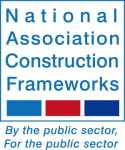Carbon Reduction Code for the Built Environment Trial Case Study – National Association of Construction Frameworks (NACF)
James Willcox, BE Sustainability, working on behalf of the NACF
Background
During my time working with large major contractors, I have been fortunate to be part of a team developing new strategic responses to different aspects of sustainability. It has given me a unique insight into combining the needs of the client with those of the business and the natural environment, in addition to the mechanisms required to enable robust reporting. So I was honoured to be approached by the National Association of Construction Frameworks (NACF) on a consultancy basis, to help design, develop and test a new carbon focused KPI. As a member body group which represents local government building, highways and civils frameworks across England and Wales, the need had arisen through the NACF to support the public sector as it tries to meet the climate emergency set out before us and its subsequent role in the Advancing Net Zero project with Cambridge University.
Challenges in implementing the Code
The first challenge in designing such a KPI was being limited to just one to cover a topic as large as carbon in the built environment. Coming from a background working for organisations with multiple KPIs across their business meant an immediate temptation to delve into the details of carbon in the value chain and designing ways that this could be measured and reduced. However, the Cambridge Carbon Code, and therefore the supporting KPI, are not meant to prescribe this level of detail. They are designed to enable industry to understand and measure progress in developing and delivering Net Zero Plans, as well as encourage collaboration and sharing of knowledge. To get this balance right meant taking a helicopter view of the issue at hand and trying to keep the solution simple yet meaningful and measureable.
The second challenge was that the NACF membership covers some £6.5bn of public sector projects annually, delivered by contractors ranging in size from small SMEs to large multi-nationals, delivering an equally diverse range of project types and sizes across multiple sectors. This meant pitching something that would be robust and meaningful in its application, yet fair and challenging to all, would be something of a balancing act. To help gauge this, early engagement sessions with contractors of different sizes were held to help understand where they were on their net zero journey and what resources they have available to support themselves and others in making the journey..
Implementing the Code - Compromises and opportunities
The compromise was to avoid a solution that focused on ambition and specificity, for example in tackling embodied or asset operational carbon, yet overlooked the basic requirement to bring everybody up to the same level.
The end result is a KPI designed to track the carbon reduction impact of contractor partners within their regional framework areas. It encourages them to establish ‘Achieving Net Zero Plans’, monitor and report a reduction in their absolute emissions from scope 1 & 2 against these plans, and gauge the level of effort employed to reduce carbon emissions elsewhere in the value chain. This latter part is fundamental, since a contractor's scope 3 carbon emissions will dwarf its footprint from scopes 1 & 2 and this requires them to support their clients and supply chains to understand and reduce carbon at all project stages. It is here that the NACF culture for sharing knowledge and being open to innovation becomes a subtextual expectation.
Lessons learned
In reflecting on lessons learned from the journey so far, it is that there are very different levels of maturity and capability in the industry when it comes to achieving Net Zero. There are those organisations who command large resources, have the prerequisite plans and procedures in place, sit on various advisory or strategic panels and seemingly are at the forefront of leading the Net Zero response. And there are those who simply don’t have the resources, perhaps limited by their size and ability to shout as loud as their larger peers, but often with no shortage of desire or ambition to be part of the solution. These organisations are also integral to their local supply chains and it is important they are not disadvantaged by the push for Net Zero. We often throw around phases such as ‘collaboration’, but I think it is important now, more than ever, that those organisations with the resource to effect change in our industry look deeper into their own scope 3 footprints and offer help and guidance at this level, in turn making it easier for those with less resource to measure, report and reduce carbon, whether that is in their business operations, embodied or asset operational. This is where organisations such as the NACF can act as the facilitator and demonstrate their own commitment to a Net Zero future.
What worked and didn’t work
It is too early to say how successful this trial will be, but it is certainly the case that NACF members recognise the call to action and are willing to work together and actively participate in this joint endeavour.
Next steps
Upon its launch, the NACF membership will adopt the KPI, focusing it to their own framework needs, ensuring complementary best-fit with existing local initiatives as required, and begin the process of gathering and reporting on absolute carbon reduction across their framework area of operation. Over time the ambition is to take things a step further and accelerate progress towards Net Zero, keeping the focus on ensuring all shapes and sizes of organisation are supported.


